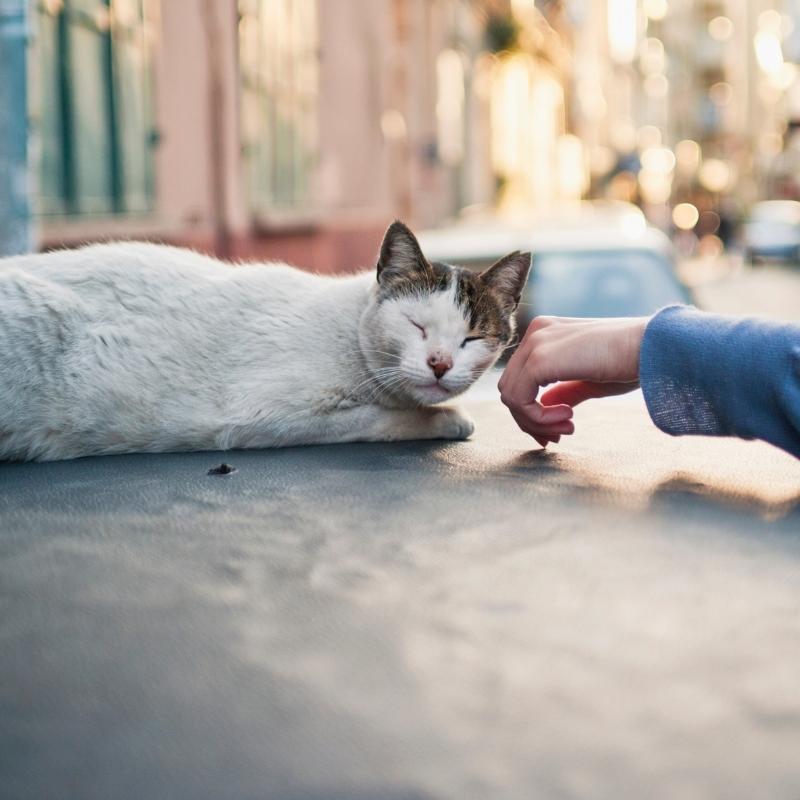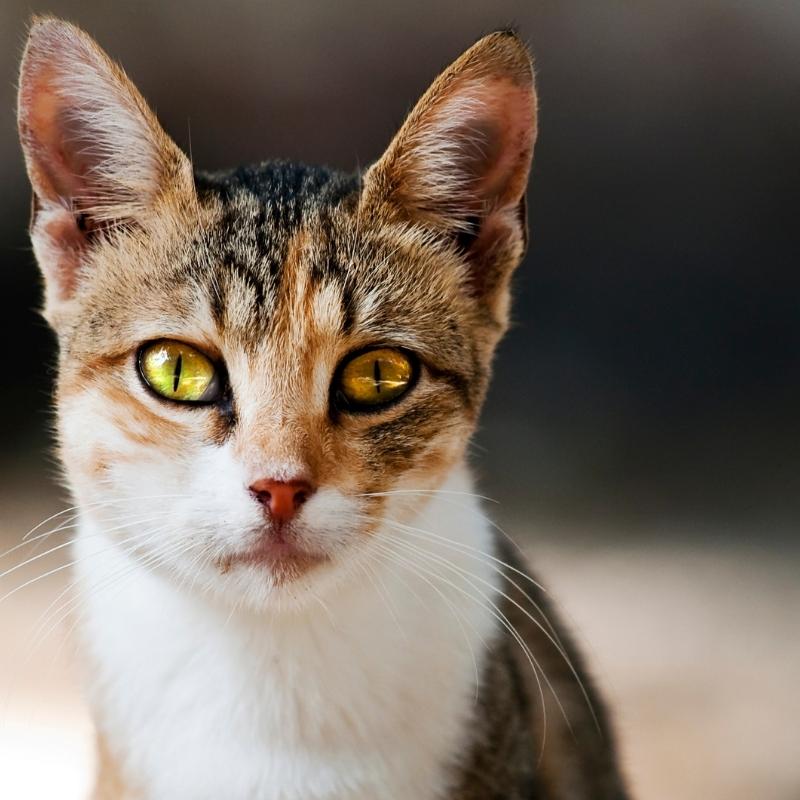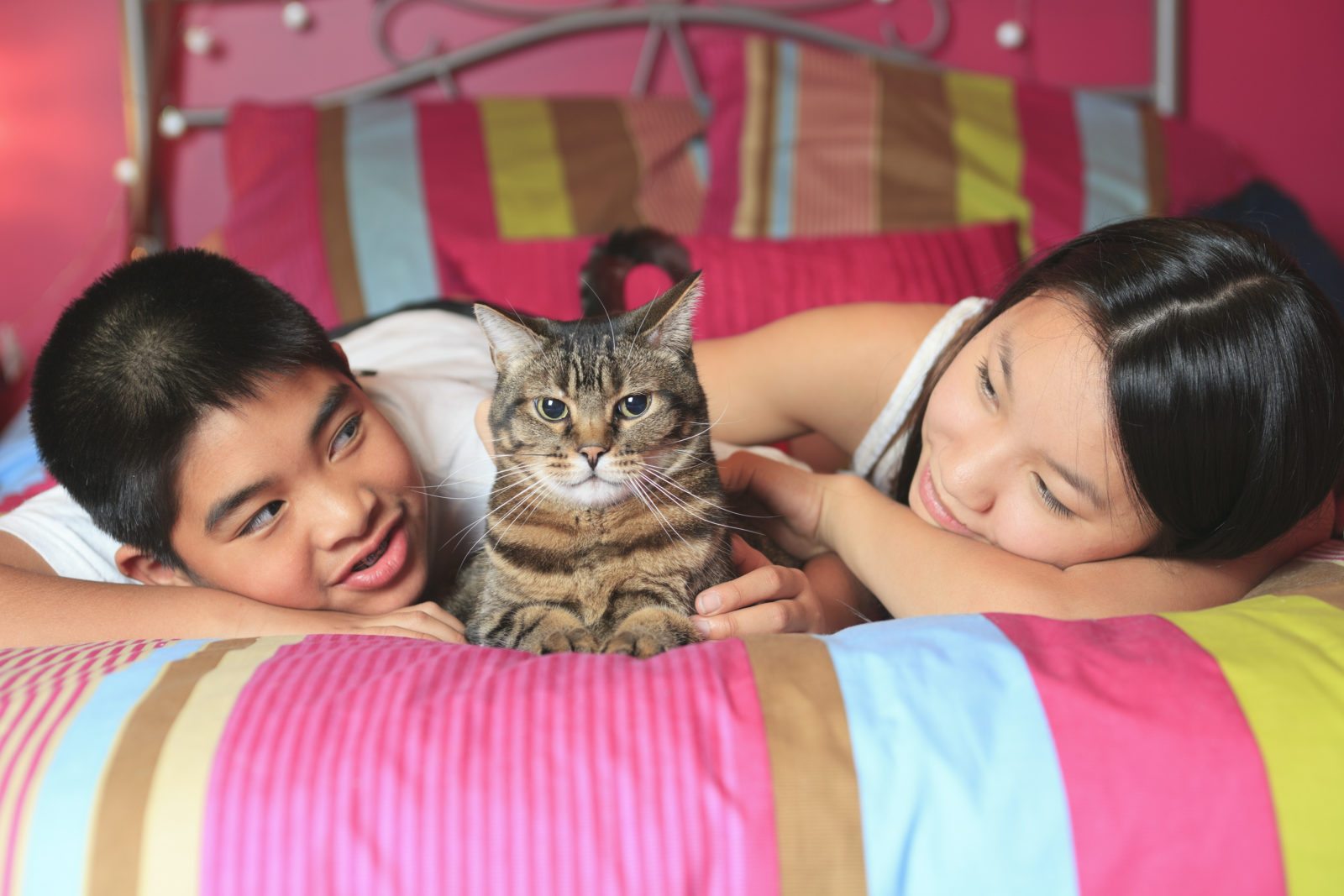Charlotte Community Cat Services
At the Humane Society of Charlotte, our goal is to support all four-legged members of our community. Typically, this means finding our whiskered friends kind and compassionate fur-ever homes.
But stray and feral felines, also called “community cats,” have different needs. These felines thrive outdoors and, depending on their level of socialization, may be too afraid of people for adoption to be an option.
Below, we discuss our Trap-Neuter-Return (TNR) program. Through this program, stray and feral cats in Charlotte can receive the care they deserve.
If you have any questions about TNR services at the Humane Society of Charlotte, call 704-333-4130 or send an email to spayneuter@humanecharlotte.org.
Jump Ahead
- What Is a Community Cat?
- How Can You Tell if a Cat Is Feral, Stray, or a Pet?
- I Found a Kitten. What Should I Do?
- Our Charlotte Trap-Neuter-Return Program
- Benefits of TNR
- How To Help Stray and Feral Cats in Charlotte
- Can I Get Rid of Stray Cats or Keep Them Out of My Yard?
- Stray Cats In Charlotte FAQs
What Is a Community Cat?

Community cats are unowned felines that roam outdoors. Though community cats may have a neighborhood caretaker who feeds them, these kitties are typically either stray or feral.
Though some people consider community cats a nuisance, they are not a threat to public health. Research shows that stray and feral cats don’t spread diseases like rabies and toxoplasmosis. In fact, felines rarely carry diseases that can make humans sick.
If anything, stray and feral cats serve their communities. As instinctive hunters, these kitties provide natural vermin control as they target mice, rats, and other small rodents.
Though the terms “stray” and “feral” are often used interchangeably, there are key differences.
How Can You Tell if a Cat Is Feral, Stray, or a Pet?
You can tell the difference between feral, stray, and pet cats by observing the animal’s demeanor and physical appearance.
Feral Cats
A feral cat is an unsocialized outdoor cat who has had limited physical contact with humans. Most feral cats are fearful of people and are very unlikely to become indoor pets.
These felines may:
- Seek hiding spots when approached by people
- Crawl, crouch, or stay low to the ground
- Avoid eye contact
- Remain quiet; no meowing or purring
- Lash out if cornered
- Have a clean, well-kept coat
Stray Cats
A stray cat is a feline who was socialized at some point in its life. Under the right circumstances, a stray cat can become an indoor pet again. Since stray cats have experienced some degree of human socialization in the past, they are generally friendlier than feral felines.
These cats may:
- Approach people, homes, and cars
- Make eye contact
- Walk with their tail high in the air
- Meow or “answer” your voice
- Appear dirty or disheveled
- Allow limited petting
Pet Cats
Pet cats may exhibit behavior similar to strays. However, since these felines are more socialized, they are more likely to approach you and be accepting of touch. They may also be more vocal.
Found a Kitten? Here’s what to do.
If you encounter a stray or feral kitten outside your Charlotte home, your first instinct might be to bring it in or contact the animal shelter. However, removing vulnerable kittens from their environment can disrupt their well-being, as their mother may be close by.
To make an informed decision, answer the following questions or refer to this helpful flyer by The Kitten Lady. The flyer utilizes the CASA method (Condition, Age, Situation, Abilities) to assess the situation effectively.
Do the kittens appear ill or injured?
If yes, contact a veterinary clinic or Charlotte-Mecklenburg Police Animal Care & Control at 311 (or 704-336-7600 if you’re outside Mecklenburg County).
Are the kittens at least two months old?
At two months old, a kitten will eat on their own, have good coordination, and weigh about two pounds. If the kittens are of age and friendly, you can try to find them loving fur-ever homes. If the kittens are still young, leave the cats and periodically check to see if the mother returns.
Is the mother around?
If the mother returns within a few hours, she’s taking good care of her kittens. You can help by providing mom and babies with food and a dry, clean shelter.
Once the kittens have been weaned and can eat wet food, you can bring them into your home and prepare them for adoption. You can also attempt to trap the mother for TNR surgery.
If the mother never returns, the kittens are likely orphaned and will need round-the-clock care. In this case, contact Charlotte-Mecklenburg Police Animal Care & Control at 311 (or 704-336-7600 if you’re outside Mecklenburg County).
Our Charlotte Trap-Neuter-Return Program
The best way to help stray and feral cats in Charlotte live longer, healthier lives is through our Trap-Neuter-Return (TNR) program. TNR is a non-lethal strategy for managing community cat populations.

This program involves:
- Humanely trapping community cats
- Spaying or neutering cats
- Vaccinating cats against rabies and other diseases
- Surgically removing the tip of one ear (“ear-tipping”)
- Returning the cats to the location where they were trapped
The Humane Society of Charlotte provides TNR surgeries at a reduced rate of $35 per cat. We are offering community cat spay/neuter surgeries by appointment.
What Is Ear-Tipping?
While a community cat is under anesthesia for spaying/neutering, the veterinarian will remove the tip of the left ear. This is called ear-tipping, and it is a universally-recognized sign of a community cat who has been spayed or neutered.
Ear-tipping is extremely safe and humane. Since the cat is under anesthesia, they don’t experience any pain. The tipped ear also saves the cat the stress of being trapped a second time.
Of course, just because you see a cat with an intact left ear doesn’t mean it needs to be spayed or neutered. Some cats in your neighborhood may have a home and may have already been sterilized.
Benefits of TNR
TNR improves the quality of life for both stray and feral cats in Charlotte while minimizing any nuisances experienced by their human neighbors. It also helps animal welfare agencies better allocate resources and provide care to animals with the greatest need.
The benefits of this program, for each of these groups, include:
For Cats
- Relieves animals of the constant stress of mating and pregnancy
- Improves cats’ coats and helps them maintain a healthy weight
- Reduces susceptibility to infectious diseases like rabies
- Helps cats live longer, healthier lives
For Neighbors
- Diminishes the size of cat colonies since sterilized cats can’t reproduce
- Eliminates annoying mating behavior (e.g. roaming, yowling, spraying, fighting)
- Saves taxpayer money by eliminating the need for animal control efforts
For Animal Shelters
- Reduces shelter intake volume
- Allows organizations to allocate resources to animals with the greatest need
- Mitigates the risk of owned animals being added to the shelter population
How To Help Stray and Feral Cats in Charlotte

If you notice a stray or feral cat prowling outside your Charlotte home, what should you do?
Step 1: Look for an Ear-Tip
If the tip of the cat’s left ear is missing, it is a community cat that has already been sterilized. If the ear is still intact, move to step two.
Step 2: Schedule An Appointment for TNR
We expect appointments to be in high demand, please ensure you are able to schedule an appointment before attempting to trap. Click here to schedule.
Step 3: Rent a Cat Trap
If you don’t have access to a humane cat trap, you can rent one through the Humane Society of Charlotte.
Trap rentals are available Monday through Friday between the hours of 9:30 a.m. and 2:30 p.m. The trap rental fee is $10 for 14 days.
A credit card is required to complete the trap rental agreement. If the trap is not returned by the agreed-upon date, a trap replacement fee of $80 will be applied to the card on file.
Step 4: Set the Trap
Place the trap in a quiet, hidden, and climate-controlled area. To lure the cat into the trap, use extra smelly treats like wet food or canned fish. For best results, read our stray cat trapping guidelines. Please do not attempt to trap a cat more than two days before your appointment.
Note: DO NOT set the trap on hot days or during extreme weather. A cat can die from hypothermia or heat stroke.
Step 5: Spay/Neuter Services
If and when you do catch the cat, cover the trap with a large towel or sheet to calm the kitty down. Then, bring the cat in the trap to the Humane Society of Charlotte on the day of your scheduled appointment.
Step 6: Release the Cat
When the cat has recovered from the sterilization surgery, release it in the same place you trapped it. Be sure to point the trap away from dangers like busy streets.
Can I Get Rid of Stray Cats or Keep Them Out of My Yard?
If a community cat is digging in your trash or leaving paw prints on your car, there are simple steps you can take to modify the stray or feral cat’s behavior.
For example, you may consider:
- Securing your trash can lids with bungee cords
- Scattering fragrant items like coffee grounds and orange peels in your garden
- Installing underpinning (e.g. lattice, chicken wire) around your porch
- Spraying areas with white vinegar to eliminate the strong scent of cat urine
- Renting humane deterrents, such as motion-activated sprinklers or audible devices, from Charlotte Mecklenburg Animal Care and Control
Though these methods may deter felines from entering your yard, TNR is the most effective way to reduce the number of stray and feral cats living in your neighborhood.
Stray Cats in Charlotte FAQs
Is it safe for cats to live outside?
Outdoor cats are exposed to many dangers, from traffic to predators to disease. However, some feral cats in Charlotte thrive outdoors. Since living outside is all they know, transitioning to a traditional home setting would be very stressful.
Are community cats dangerous?
Generally, no. Though some community cats will scratch or bite if cornered, they tend to avoid human contact. Research also suggests that stray and feral cats rarely carry germs that could make a person sick.
Can you adopt a community cat?
It depends. Feral cats with no previous human contact are very unlikely to become pets. However, stray cats can become pets if given the time to reacclimate to humans. You can also look on our site if you’d like to adopt a cat in Charlotte.
